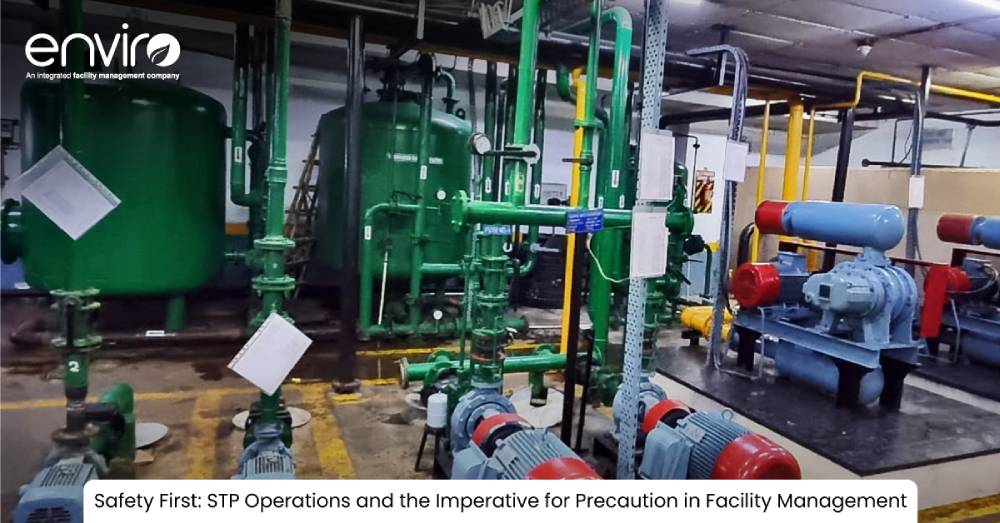Last week of May, A leading Real estate player from North India, who had outsourced STP cleaning & operations to an agency landed in trouble. As the 3 of the STP operators became unconscious, a brave Security guard jumped to help, he also, almost became unconscious. Other guards pulled the 4 of them out. They were hospitalised, 2 were discharged within few hours, however 2 were in ICU for 2 days.
This forces us to ask the basic question, Are we taking enough precaution during STP cleaning and what are they? Would an Facility Management company done a better job.
Integrated Facility Management (IFM), ensures a safe and efficient functioning of Sewage Treatment Plants (STPs). These systems, often tucked away in basements or service areas, play a silent yet vital role in the environmental health of a building. However, STP operations come with significant risks, especially due to the buildup of toxic gases like hydrogen sulfide, methane, and carbon dioxide, which can pose serious threat to the lives of operational staff if not managed properly.
Unfortunately, India has witnessed several instances where workers have fallen unconscious or even died due to unsafe entry into STP chambers without proper precautions. For facility management teams, this is a non-negotiable area of concern, and the need for proactive safety measures has never been more pressing.
Understanding the Risk
STPs are confined spaces where untreated sewage accumulates and decomposes, leading to the formation of hazardous gases. These gases:
. Are often colorless and odorless
. Can displace oxygen, leading to suffocation
. May cause dizziness, unconsciousness, or death within minutes if exposure is high
The danger is amplified when basic safety measures are skipped, especially in the unorganised sector.
Precautionary Measures: Traditional, But Effective
Even in low-resource or budget-restrained environments, the following traditional practices can dramatically reduce risk:
1. Ventilation Before Entry
Always use a forced air blower or a large fan to ventilate the STP chamber for at least 20–30 minutes before anyone enters. This flushes out the accumulated toxic gases and brings in oxygen.
2. Buddy System with Rope
No technician should enter an STP tank alone. A buddy system must be followed, where one person remains outside, holding a safety rope tied to the person inside. This simple setup can be life-saving during emergencies.
3. Manual Gas Check
Where gas detectors are not available, a basic check can involve lowering a flame or candle (inside a protective jar) into the chamber. If it extinguishes quickly, the oxygen level is too low—entry must be halted immediately. (Note: This method is rudimentary and not recommended in modern practices, but still used where tech access is limited.)
4. Access Scheduling
STP cleaning and checks should always be done during daylight hours, with proper lighting and supervision—never at night or during minimal staff presence.
Modern Safety Interventions in STP Operations
With an Integrated facility management providers like Enviro, technological adoption is bridging the safety gap.
1. Multi-Gas Detectors
A handheld digital gas detector is a must-have tool. These devices detect presence of:
. Hydrogen sulfide
. Methane
. Ammonia
. Oxygen deficiency
Using one before any man-entry operation gives a clear “go/no-go” decision and adds a layer of scientific validation to safety.
2. Confined Space Entry Permits
A formal Confined Space Work Permit System should be implemented. Entry is allowed only after supervisor clearance, ventilation, gas testing, and manpower readiness has been done.
3. Tripod with Winch System
Modern IFM setups now install tripod assemblies with winch mechanisms for confined space entries. These allow for safe lowering and immediate evacuation if needed.
4. Training & Simulation
Regular mock drills and refresher trainings ensure staff are aware of risks, know how to use safety equipment, and act calmly during emergencies.
Facility Management’s Ethical Responsibility
From a facility management perspective, the safety of STP staff is more than just a compliance checklist—it is an ethical commitment. FM companies must:
. Educate RWAs and property owners about the importance of hiring trained and equipped manpower
. Insist on STP safety SOPs in their service contracts
. Set aside a portion of operational budget for safety gear and training
. Maintain incident logs and conduct root cause analyses of any near-miss or health scare
STP operations are necessary, but it should never cost lives. Whether you’re managing a residential complex, commercial tower, or industrial estate, integrating STP safety protocols into your facility services plan is a strategic, operational, and humanitarian priority.
Let’s make “safety-first” more than a slogan. Let’s make it standard practice.





 WhatsApp Business +91 88000 09776
WhatsApp Business +91 88000 09776
 CSC
CSC  WhatsApp Business
WhatsApp Business 